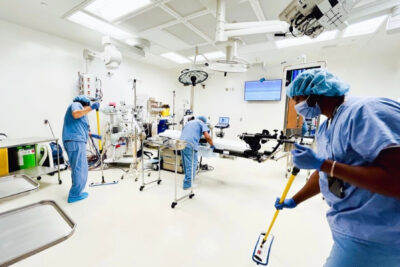At Humber River Health (Humber), breaking new ground is the norm. The team, including staff and physicians, work tirelessly to improve processes and embrace new ideas. This innovative spirit is evident in their latest initiative: the Hyper-Throughput Operating Rooms, specifically designed for faster and safer anterior hip replacements. This approach is inspired by leading international healthcare practices and is a testament to Humber’s commitment to teamwork and excellence.
On December 21, the hospital celebrated the successful completion of its fourth Hyper-Throughput Operating Room pilot. This follows the success of the first pilot in October, showcasing Humber’s dedication to advancing healthcare, and how they are stepping up to find innovative ways to improve throughput and lower costs to address the growing demands of the provincial healthcare system.
“This truly was a collaborative effort, engaging the entire team throughout the planning process,” commented Jhanvi Solanki, Vice President of Clinical Programs. “Hyper-Throughput Operating Rooms break down each step within the process and evaluate its effectiveness – leaning out waste and introducing the concept of parallel processing has allowed micro changes to result in big time savings. We are proud to be doing our part to help the province tackle the surgical backlog.”
Hyper-Throughput Operating Rooms are not about set number of procedures per day, but more so about improving the flow of procedures and leaning out wastes.
Dr. Sebastian Rodriguez-Elizalde, Dr. Barry Cayen and Dr. Justin Chang, along with the Humber team, played a pivotal role in these pilot days. On November 24, Dr. Rodriguez-Elizalde performed an impressive 14 anterior hip replacements in just one day, setting a new standard in surgical efficiency without compromising patient safety in Canada. Drs. Chang and Cayen are also performing greater than typical volumes. Hyper-Throughput Operating Rooms are not about set number of procedures per day, but more so about improving the flow of procedures and leaning out wastes. The lessons learned from these pilot days are broadly applicable to all operating rooms. For example, the concepts of parallel and lean processing can help improve block utilization per day, per surgeon daily. This benefits the system at large because in many instances, this allows the surgeon to add an additional case to their lists.
“In a typical day, the orthopaedic surgeons and I will usually perform three to four surgeries per day in one operating room,” said Dr. Rodriguez-Elizalde. “Working with hospital staff, we were able to effectively triple our surgical productivity through process improvements at the beginning and end of the surgeries. The most important element of innovation is ensuring there is a quality and patient safety framework.” All procedures are performed using navigation technology to ensure the utmost safety
standards are met.

Intellijoint’s technology was critical to this effort, as it eliminates the need for intra-operative X-rays, while simultaneously reducing post-surgery complications and ensuring the highest level of safety. “As a local Ontario technology business, we are proud to work with hospitals like Humber River Health that are leading the nation in clinical and technological innovation,” says Armen Bakirtzian, Co-Founder and CEO of Intellijoint Surgical Inc. “Together, we have demonstrated how hospitals and innovators can collaborate in new and highly effective ways.”
These pilot Hyper-Throughput Operating Rooms have been transformative, setting an important example of how hospitals can use lean processing and teamwork to improve operational efficiencies, while simultaneously reducing wait times and surgical backlog. Thanks to the parallel processes and the collective efforts of Humber staff, there was a marked decrease in total case time, operating room turnover, housekeeping, as well as set-up and takedown times.
Furthermore, patient outcomes were consistently exceptional; all patients bypassed the PACU, and there were no complications, with each patient being discharged that same day. There was even a reduction in garbage and linen usage, exemplifying the hospital’s commitment to sustainability. While recognizing that not all procedures can benefit from such high-throughput settings, the advancements made will continue to inform enhancements across the hospital’s operating rooms.
Looking ahead, Humber is working on transferring the learnings across as many surgical procedures as possible, marking another step in Humber’s journey of innovation. This initiative is about more than just surgical improvements; it is about reimagining healthcare possibilities, enhancing patient care, and making healthcare more accessible.
Humber River Health’s efforts are a shining example of what can be achieved when dedication meets innovation. The team’s relentless pursuit of better patient outcomes and their contribution to the community pave the way for a bright future in Canadian healthcare.


